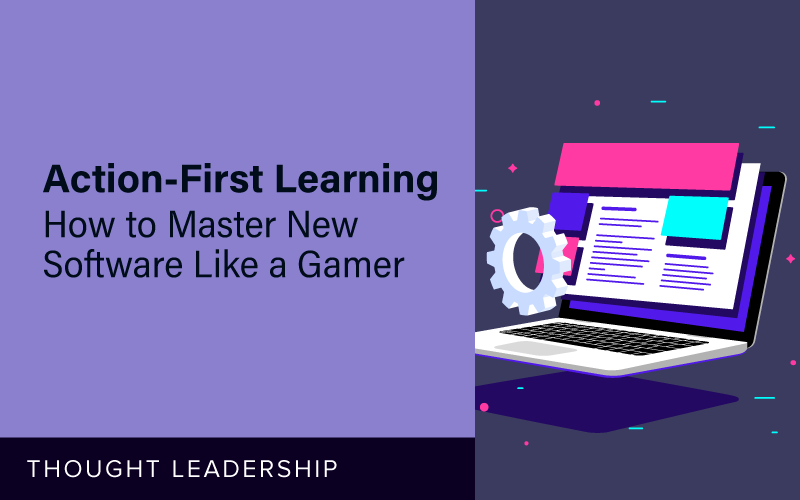You know that feeling you have when you first arrive in a new city? Even with a GPS, the streets are confusing, the landmarks are unfamiliar, and every turn feels like a question. But the longer you’re there, the more you start to notice patterns, and things slowly begin to make sense. Learning new software is a lot like navigating a new terrain: overwhelming at first glance, but entirely manageable once you take action and start moving.
That’s the essence of the action-first learning approach we explored in a recent ELB Learning® webinar, featuring Karl Kapp, professor of instructional technology at Bloomsburg University. The session challenged us to rethink how we tackle software mastery—not as a painful slog through manuals and tutorials, but rather as an active, playful process that builds confidence and skill.
Just as gamers rarely read the manual before diving into a new game, the key to learning software is to start by doing. Games teach through immediate action. You don’t learn Pac-Man by poring over the rules; you learn by eating those little yummy digital dots. You don’t master Minecraft by reading instructions; you have to get in there and start stacking blocks, baby.
The same philosophy applies to professional tools.
The Metaphor Theory
The process begins with strategic exploration. Instead of clicking around randomly or memorizing commands, just focus on orienting yourself. Figure out where the menus are, locate the core functions, and get a feel for the layout. Many software tools are built around metaphors like a desktop (Microsoft Windows), a library (Lectora™), a timeline (video editors and animation tools), a newspaper (MicroBuilder®), or even a photo lab (Adobe Photoshop). Once you identify the metaphor, the software begins to reveal its logic, enabling you to better predict how it will behave.
Next comes taking action. Like a gamer embarking on a quest, choose a small but meaningful project —something you genuinely care about, like building a budget in a spreadsheet, creating a short eLearning module, or designing a graphic. The point isn’t perfection; it’s progress. And as you progress, you build momentum. Action is a much better teacher than passively watching tutorials or flipping through a manual. Even mistakes are valuable feedback that points you toward the right path.
Practice with Play
Then comes the most overlooked stage: play. Repetition with variation turns clumsy practice into fluency. Each time you repeat a task—adding a twist, layering in new features—you build speed and confidence. Mastery doesn’t happen in giant leaps. It’s the amalgamation of small experiments and challenges that add up to your cumulative skill level. And don’t overlook the importance of reflection, too. Keep a software journal or record your process as a reflection tool to help you stay organized. It can help you keep track of what worked, what didn’t, and help you hone in on how to approach the next challenge armed with that helpful information.
Action-first learning transforms frustration into growth. Instead of getting stuck, you build a “frustration plan” that includes stepping away, resetting, and coming back with fresh eyes. Just as a night’s sleep helps your brain consolidate what you’ve learned, intentional breaks create space for insights and breakthroughs.
For learning professionals, this approach isn’t just about software. It’s a mindset. By modeling action-first strategies, you can design training that gets learners hands-on quickly, scaffolds tasks into manageable mini-adventures, and encourages play as a form of practice. The result is faster adoption, greater confidence, and a deeper sense of mastery.
At ELB Learning, we know that mastering tools is only part of the equation. True impact comes from aligning learning strategies with organizational goals. That’s why our learning strategy services help teams cut through the noise, prioritize what matters, and design experiences that actually stick.
Want to see the full discussion and gather even more practical tips? Watch the webinar replay below.
And if you’re ready to transform your learning programs with a proven strategy, learn more about ELB Learning’s learning strategy services.
_______________
Disclaimer: The ideas, perspectives, and strategies shared in this article reflect the expertise of our featured speaker, Karl Kapp. Be sure to follow him on LinkedIn to explore more of his insights.





